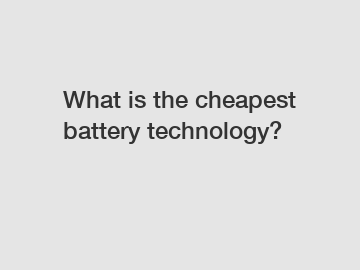What is the cheapest battery technology?
What is the cheapest battery technology?
As energy demands continue to rise and the world aims to reduce carbon emissions, finding affordable and sustainable battery technology has become a growing priority. Battery technology has made significant advancements in recent years, with various types of batteries dominating the market. However, when it comes to determining the cheapest battery technology, several factors need to be considered. In this article, we will explore different battery technologies, their costs, and their potential for widespread adoption.
1. Lead-Acid Batteries:

Lead-acid batteries have been the most widely used and cheapest battery technology for decades. Although they have a low energy-to-weight ratio, they offer a high power-to-weight ratio and are capable of delivering a quick burst of energy. Lead-acid batteries are primarily utilized in automotive applications, where cost-effectiveness is often prioritized over energy density. While these batteries are relatively affordable, their limited lifespan and environmental concerns associated with lead make them less attractive in some scenarios.
2. Nickel-Cadmium (Ni-Cd) Batteries:
Nickel-cadmium batteries have also been popular in certain applications, mainly due to their higher energy density compared to lead-acid batteries. However, the rising costs of cadmium and the environmental hazards it presents have led to a decline in their usage. Furthermore, Ni-Cd batteries suffer from the "memory effect," a reduction in capacity if not fully discharged before recharging. Therefore, despite their moderate affordability, their limitations have led to the exploration of alternative technologies.
3. Lithium-ion (Li-ion) Batteries:
Lithium-ion batteries have revolutionized portable electronic devices and electric vehicles. They offer higher energy density, longer cycle life, and a lower self-discharge rate compared to lead-acid and Ni-Cd batteries. Initially, Li-ion batteries were expensive to produce and had limited availability. However, technological advancements, increased production volumes, and economies of scale have led to a significant reduction in their cost. As a result, Li-ion batteries have become the new standard for many applications.
4. Sodium-Ion Batteries:
In the pursuit of even cheaper battery technology, researchers have been exploring sodium-ion batteries as a potential alternative to lithium-ion batteries. Sodium is abundant and widely accessible, making sodium-ion batteries an attractive option for cost-effective energy storage. Although sodium-ion batteries are still in the early stages of development, they hold promise for cheaper energy storage solutions. However, they currently offer lower energy density and shorter lifespan compared to their lithium-ion counterparts.
5. Flow Batteries:
Flow batteries differ from traditional batteries as they store energy in external tanks. By using a reversible chemical reaction between two dissolved elements, flow batteries offer a unique advantage: the ability to scale energy storage capacity independently of power. While flow batteries have shown potential for long-duration and stationary applications, their relatively high overall system costs currently limit widespread adoption. However, ongoing research and technological advancements may drive down the costs in the future.
In conclusion, determining the cheapest battery technology depends on the application's specific requirements and priorities. Lead-acid batteries remain the most affordable option for certain applications. However, their limited lifespan and environmental concerns make them less suitable for many emerging energy storage needs. Lithium-ion batteries, once expensive, have become more cost-effective due to improved technology and manufacturing processes. While lithium-ion batteries dominate the market, researchers are actively exploring sodium-ion batteries as a potentially cheaper alternative. Flow batteries, with their unique design, offer longer-duration storage but currently suffer from higher costs. Finding the cheapest battery technology is an ongoing challenge, but with consistent technological advancements and research efforts, affordable and sustainable options are within reach.
If you are looking for more details, kindly visit Graphite Block for Blast Furnace, carbon artificial graphite block, 3 Inch Crucible.

Comments